Key Points:
- Gray wolves, the biggest of the canids, grow up to 5 feet long and inhabit parts of the entire northern hemisphere. They typically run in packs and are led by a dominant alpha male and female, which always eats first at the site of a kill.
- The wild dogs of southeast Asia are called dholes, which are omnivores that will eat mammals as large as deer, but also insects, lizards, and even fruit. When hunting in packs, their behavior resembles hyenas–they disembowel and eat their prey while it’s still alive.
- Red foxes can be found in many areas of the northern hemisphere and are more widely distributed than gray wolves. They typically live in pairs, and fox cubs are cared for by both parents and non-reproductive females.

Dogs, or canids, have been around for tens of millions of years, but breeds of the loyal and loving dog who’s become part of the family have been around for only 15,000 years or so. There are quite a few wild dog breeds still in the world. Nearly every pet dog is descended from the gray wolf, and humans have managed to domesticate dogs into all manner of sizes and shapes, from the huge Irish wolfhound to the tiny Chihuahua, to the boxy English bulldog with its smashed-in face to the fast and slender Greyhound with its long and elegant muzzle.
There are still at least 40 species of wild dog breeds. Unlike domesticated dogs, most share a basic body plan in that they have a slender but strong body, a long muzzle, a long, bushy tail, large ears, and powerful jaws for their size. Wild dogs may be solitary or hunt in packs, and some are endangered. Here are 10 of them:
#10: Red Wolf
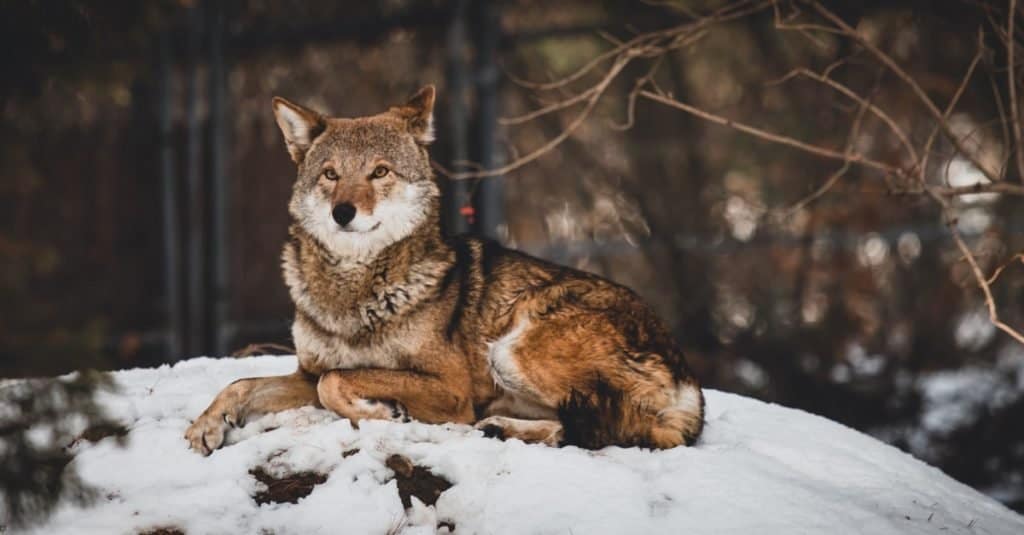
©mruizseda/Shutterstock.com
Biologists still aren’t quite sure if the red wolf is its own species or whether it is a cross between a gray wolf and a coyote or if it’s some kind of subspecies of the eastern wolf that lives in Canada. The red wolf is found in the southeastern part of the United States. Whatever sort of dog it is, the red wolf is considered critically endangered by the IUCN and was almost wiped out due to bounty hunting, destruction of its habitat, and interbreeding with coyotes.
The red wolf is a bit bigger than a coyote but smaller than a gray wolf and gets its name because of areas of red on its coat. Its ears are larger than both the gray wolf’s and the coyote’s, and its legs and muzzle are long and slender. In terms of sociability, it is also in the middle between the gray wolf and the coyote, as it’s more sociable than the latter and less sociable than the former. The red wolf is monogamous, and both parents help raise the cubs, who are born in early spring.
#9: Gray Wolf

©Bildagentur Zoonar GmbH/Shutterstock.com
The forebear of the modern dog, the gray wolf has been the subject of mythology, persecution, and overall fascination for millennia. The biggest of the canids is often 3.25 to 5 feet long with a tail that’s 1.25 feet long and stands between 1.97 to 2.95 feet at the shoulder. Males are a little larger than females. The wolf used to range widely in most of the Northern Hemisphere, and the color of its thick coat varies depending on where it lives. Wolves in the extreme north have white coats, while wolves in more southern areas have the iconic gray coat or coats in shades of brown or black. Most wolves have a mix of colors in their coat.
Wolves famously live in packs with a dominant, or alpha male and female. The alphas eat first at a kill, which could be an animal as large as an elk. Their occasional predation of livestock has led to their persecution, and wolves have been extirpated in many of their native hunting grounds.
Gray wolves have been known to breed with coyotes and with domestic dogs. One example of this is the Czechoslovakian wolf dog, which is used as a police dog in Slovakia and the Czech Republic.
#8: Red Fox
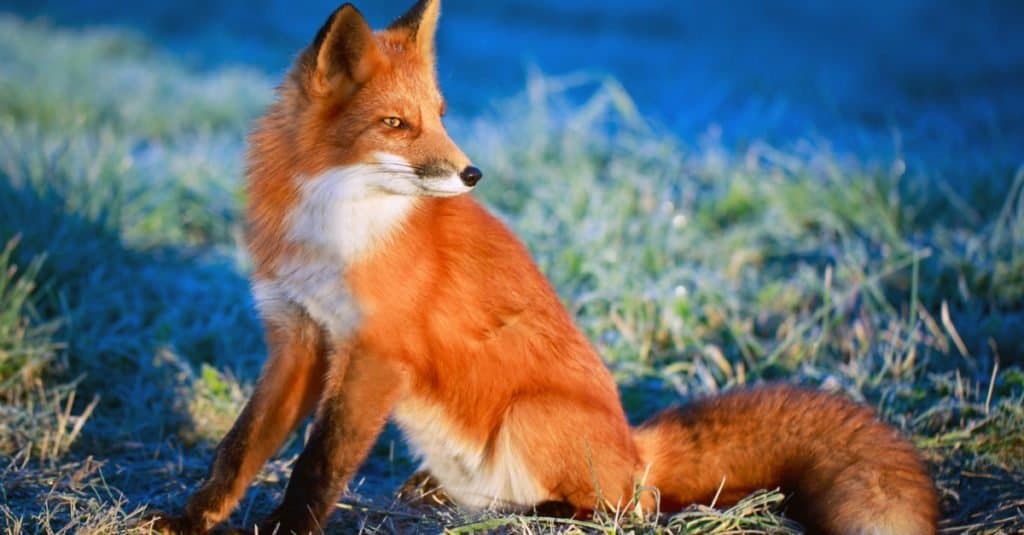
©DragoNika/Shutterstock.com
The red fox is the subject of nearly as many myths and tales as the gray wolf, but it’s not quite as persecuted. This fox can have a classically red coat, but its coat can also be shades of silver and rust. Its tail is wonderfully bushy, with its fur tipped with white. The lower parts of the red fox’s legs are black and its belly is white. Its muzzle and ears are pointed.
Foxes hunt both night and day. Its primary targets are rabbits and rodents though it will take chickens if the opportunity presents itself. It often hunts in thickets and finds prey using its acute hearing. It leaps high in the air and pins the prey to the ground with its front paws. It then grabs the animal by the neck and carries it back to its lair.
Foxes live as pairs, with a female and male in overlapping territories that may be shared by relatives who are too young to breed. Cubs are cared for by both parents and non-reproductive females. The red fox is even more widely distributed than the gray wolf and is found in many areas in the northern hemisphere. This includes the Arctic, Central America, Central Asia, and North Africa. They’ve even been introduced into Australia.
#7: Maned Wolf
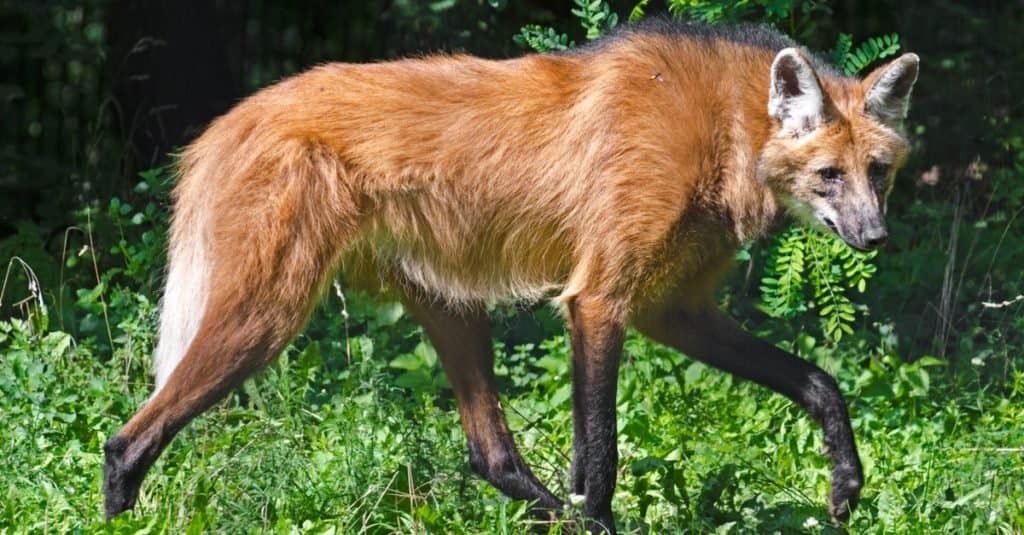
©JWKS Photomancy/Shutterstock.com
Found in central and eastern countries of South America, this wild dog is known for its disproportionately long legs and the dark mane on the back of its neck. The rest of its coat is reddish, rather like the red fox, though its long tail may be white or black, and its legs, which are long to let it see over the tops of the grass, have black “stockings.” Its foxlike muzzle is also dark. It lives in open grasslands and farms and has benefited, somewhat, from the clearing of forests. Its diet includes mice, birds, ants, and rabbits and it will also eat fruit. Now and then the maned wolf will take chickens, which has led to it being persecuted.
Maned wolves form pairs whose territories overlap, though they only seem to come together once a year to mate. This is why the maned wolf is usually classified as a solitary animal. It grows to be between 4 and 4.5 feet long with an 11 to 18-inch long tail. It weighs between 44 and 51 pounds.
#6: Arctic Fox
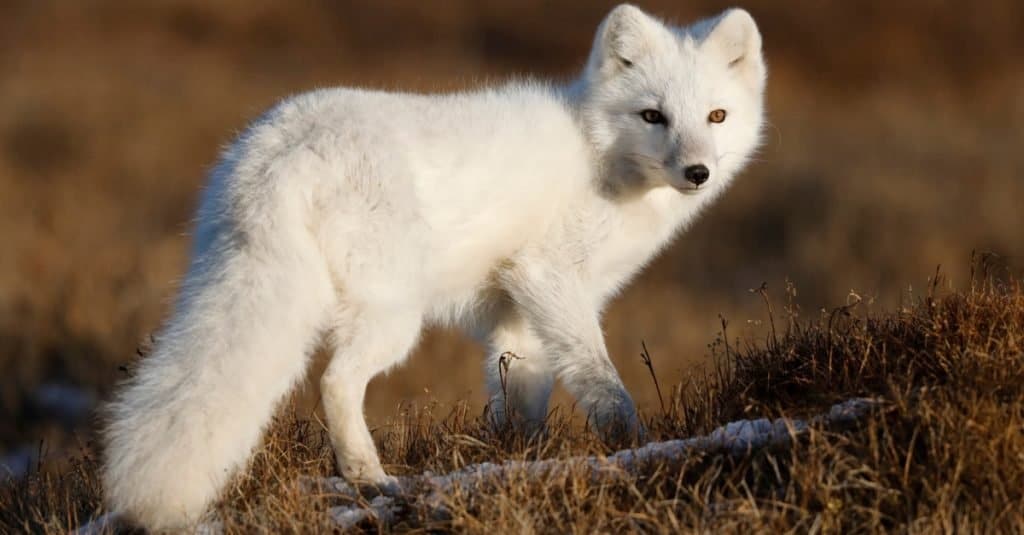
©Agami Photo Agency/Shutterstock.com
This little fox is known for the pure white coat it develops during winters in the Arctic, where it lives. In the summer the fox’s coat looks gray. Both colors are a form of camouflage. The pure white coat helps the fox disappear in the snowy landscape, while the gray blends in with the grayish hills and plains. The Arctic fox has a short muzzle and small ears, short legs, and a short tail. These adaptations help the animal retain heat during the Arctic’s intensely cold winters. Here are some interesting facts about Arctic foxes that we have found in our research:
- There are at least several hundred thousand arctic foxes in the wild.
- Lemming, a species of rodent found in the Tundra, are the main source of food for the in-land areas for the arctic fox.
- The Arctic fox species population increases and decreases in proportion to the lemmings in the area.
- The arctic fox doesn’t have to hibernate, due to the small size and compact nature of their anatomy, they can distribute heat well and sustain themselves longer.
- The skin beneath their fur is actually darker in color which helps in retaining heat.
- The arctic fox stalks the lemmings moving under the snow and at the right moment, nose dives into the snow to catch its prey.
- Arctic foxes do not live long in the wild. On average their lifespan is 3-4 years at the most.
- When food is scarce the arctic fox can be seen scavenging.
- Due to global warming, the Arctic fox is losing their natural habitat.
#5: Jackal

©Sharon Haeger/Shutterstock.com
Jackals belong to the Canis family and are closely related to dogs. They look like wolves but lack the courage that is associated with wolves and are compared with hyenas. There are several species of jackal, and their characteristics depend on where they live. Most species live only in Africa, especially east and southern Africa, though the golden jackal can be found in Eurasia. They prefer wide open grassy lands and hunt at night. They have no fixed social structure as they can live alone, in pair or in packs. They are medium-sized wild dogs and omnivores that will eat whatever is available. This includes smaller mammals, reptiles, and birds. Sometimes they follow lions and other bigger predators and eat their leftovers. These dogs are crepuscular, and the main social unit is a male and female jackal and their subadult children. Like gray wolves and foxes, jackals figure heavily in human mythology and folklore. The Bible mentions the jackal at least 14 times.
#4: Dhole
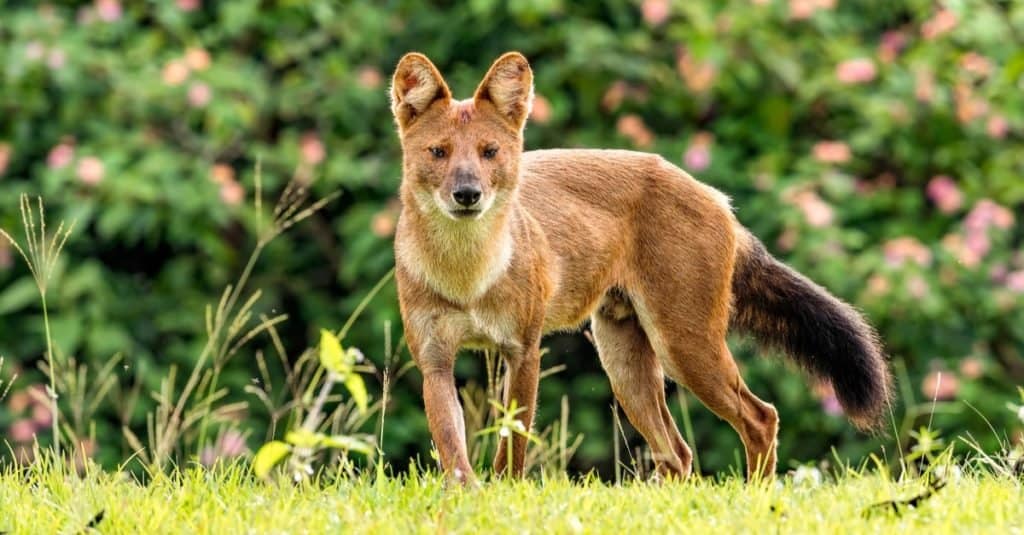
©Nimit Virdi/Shutterstock.com
The dhole is also called the Asian Wild Dog or Indian Wild Dog are an average-sized dog that stands about 20 inches at the shoulder with a body length of about 35 inches and a 16 to 18-inch long tail. It is found across Southeast Asia. Like jackals, dholes are omnivores and will eat mammals as large as wild pigs and deer as well as insects and lizards. It will also eat fruit.
They are highly social animals and the number in a pack can go up to 20 – 40 at times. The hierarchy pattern is very rigid and the pack also contains several breeding females. When they hunt in packs, dholes behave very much like hyenas, with the prey being disemboweled and eaten while it’s still alive. Dholes are long-lived for dogs and can live 16 years in captivity. They are endangered species as there are less than 2500 dholes left in the world.
#3: Coyote

©JayPierstorff/Shutterstock.com
The coyote, found in most places in the United States, Canada, and Mexico, has a grizzled coat that’s yellowish around the ears, feet, and legs and gray and white everywhere else. There may be a black tinge on the animal’s back, tail, and shoulders. This very adaptable dog has even been found in urban areas. Like the fox, it stalks its prey and pounces upon it. Its natural prey includes deer, pronghorns, wild sheep, and livestock. It will also eat carrion and garbage.
The coyote population is flourishing despite making enemies of humans for its tendency to prey on livestock. They can be found anywhere in North America and have spread down to eastern Panama. Originally, they were only found in the prairies and deserts of central and western North America. But as humans settled and expanded territory for habitation in the 1800s, they killed off many of the wolves and cougars that were natural enemies of the coyote. Because of this, coyotes were allowed to multiply in numbers unchallenged.
#2: Dingo
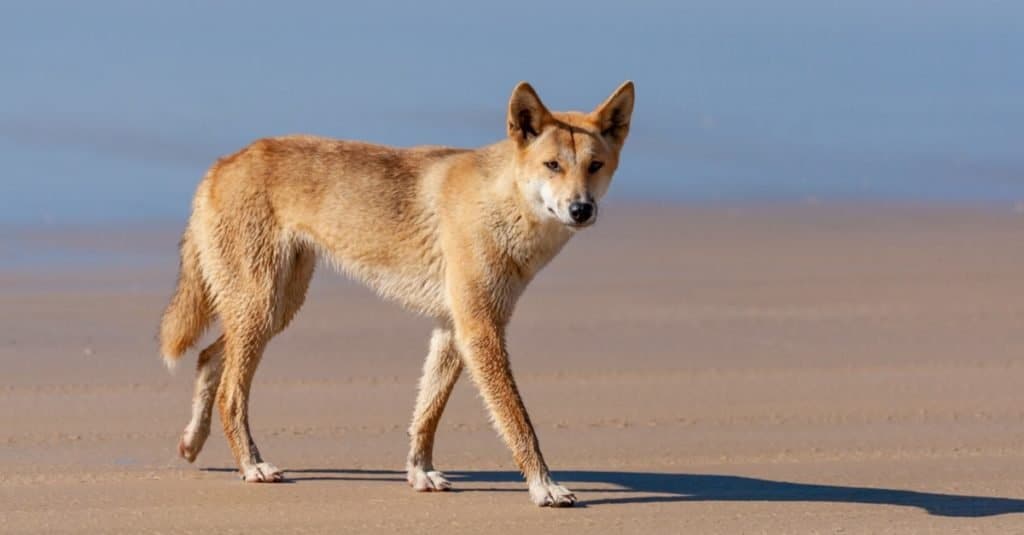
©Jason Cassidy/Shutterstock.com
Like the red wolf, biologists aren’t sure if the dingo of Australia is its own species or a subspecies of a domestic dog that went feral or a type of wolf. Whatever its origins, it has been wild for a least 10,000 years and has the typical body type and coloration of a wild dog, with brown and reddish fur on its body with white on its feet, chest, and the top of its tail.
They are considered apex predators and the largest known ones in the Australian continent. They are carnivores nut are known to eat fruits, nuts and grains as well. Dingos are highly intelligent and possess the ability to solve problems and create plans. Dingos sometimes form packs where there is one dominant male and one dominant female, the dominant female often kills the offspring of other females in the pack. The dingo is found in temperate and tropical forests and grasslands.
#1: African Wild Dog
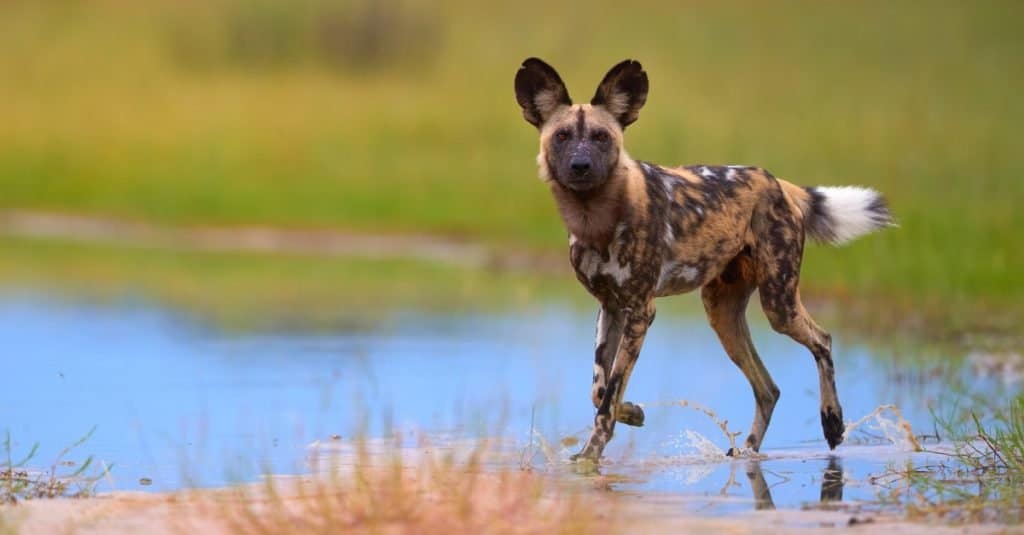
©Martin Mecnarowski/Shutterstock.com
The African Wild Dog, an endangered species with only around 6600 of them left, has a distinctive look, with its lean body, huge ears, and coat that’s mottled white, black, and tan. Its coat has given it the scientific name of Lycaon pictus, which means painted wolf. Once found throughout Africa, it’s now found mostly in the southeastern part of the continent. Extremely social, it can form packs of up to 30 or more dogs, however, they do not make good pets and if faced in the wild, they should be treated with extreme caution. It hunts during the day, and its main prey is antelopes. Because the packs are so large, the prey can be chased until it drops from exhaustion. Then, unlike wolves, the cubs are allowed to eat first. There are five subspecies of African wild dogs.
Summary Of The Top 10 Wild Dog Breeds In The World
Here’s a recap of the top 10 breeds that make up dogs that run wild:
| Rank | Dog Breed |
|---|---|
| 1 | African Wild Dog |
| 2 | Dingo |
| 3 | Coyote |
| 4 | Dhole |
| 5 | Jackal |
| 6 | Arctic Fox |
| 7 | Maned Wolf |
| 8 | Red Fox |
| 9 | Gray Wolf |
| 10 | Red Wolf |
The photo featured at the top of this post is © iStock.com/JohnCarnemolla
Ready to discover the top 10 cutest dog breeds in the entire world?
How about the fastest dogs, the largest dogs and those that are -- quite frankly -- just the kindest dogs on the planet? Each day, AZ Animals sends out lists just like this to our thousands of email subscribers. And the best part? It's FREE. Join today by entering your email below.
Thank you for reading! Have some feedback for us? Contact the AZ Animals editorial team.







